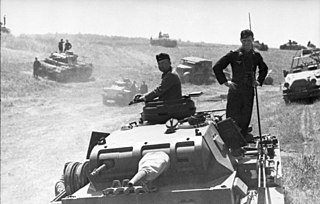
The Bernhardt Line, or Reinhard Line, was a German Army defensive line in Italy during the Italian Campaign of World War II. Having reached the Bernhardt Line at the start of December 1943, it took until mid-January 1944 for the US Fifth Army to fight its way to the next line of defences, the Gustav Line. The Bernhardt Line was defended by XIV Panzer Corps, part of the German Tenth Army.

The Allied invasion of Italy was the Allied amphibious landing on mainland Italy that took place from 3 September 1943, during the Italian campaign of World War II. The operation was undertaken by General Sir Harold Alexander's 15th Army Group and followed the successful Allied invasion of Sicily. The main invasion force landed on the west coast of Italy at Salerno on September 9 as part of Operation Avalanche, while two supporting operations took place in Calabria and Taranto.

Operation Baytown was an Allied amphibious landing on the mainland of Italy that took place on 3 September 1943, part of the Allied invasion of Italy, itself part of the Italian Campaign, during the Second World War.

The 13th Panzer Division was a unit of the German Army during World War II, established in 1940.

The 16th Infantry Division of the German Army was formed in 1934. On 26 August 1939 the division was mobilized for the invasion of Poland (1939). It participated in the Battle of France in August 1940. The division was then split, resulting in two independent units: The 16th Panzer Division and the 16th Motorized Infantry Division. Then later, from 1944 onward, combined with other non 16th elements, was known as the 116th Panzer Division.
XXXXVIII Panzer Corps, was a corps-level formation of the German Army which saw extensive action on both the Eastern and Western Fronts during World War II.
The XXVIII Army Corps was a corps which served in Nazi Germany's Wehrmacht during World War II. The corps was created on May 20, 1940 in Wehrkreis III. During the war, the corps was subordinated to the German 6th, 16th, 18th, and 3rd Panzer Armies. In 1945, the corps was briefly named Armeeabteilung Samland. The corps fought in Samland until annihilated in late April 1945.

Gerhard Helmut Detleff Graf von Schwerin was a German General der Panzertruppe during World War II.

The Battle of the Argenta Gap was an engagement which formed part of the Allied spring 1945 offensive during the Italian campaign in the final stages of the Second World War. It took place in northern Italy from 12 to 19 April 1945 between troops of British V Corps commanded by Lieutenant-General Charles Keightley and German units of LXXVI Panzer Corps commanded by Lieutenant General Gerhard von Schwerin.
Gothic Line order of battle is a listing of the significant formations that were involved in Operation Olive, the Allied offensive on the Gothic Line in northern Italy, August–September 1944, and in the subsequent fighting in the central Apennine mountains and on the plains of eastern Emilia–Romagna up to April 1945.

The Trasimene Line was a German defensive line during the Italian Campaign of World War II. It was sometimes known as the Albert Line. The German Commander-in-Chief (C-in-C), Generalfeldmarschall Albert Kesselring, used the line to delay the Allied northward advance in Italy in mid June 1944 to buy time to withdraw troops to the Gothic Line and finalise the preparation of its defenses.
Operation Diadem order of battle is a listing of the significant formations that were involved in the fighting on the Winter Line and at the Anzio bridgehead south of Rome during Operation Diadem in May - June 1944 which resulted in the Allied breakthrough at Cassino and the breakout at Anzio leading to the capture of Rome.

Traugott Herr was a German general during World War II who commanded the 14th Army and the 10th Army of the Wehrmacht. He was a recipient of the Knight's Cross of the Iron Cross with Oak Leaves and Swords.

The 116th Panzer Division, also known as the "Windhund (Greyhound) Division", was a German armoured formation that saw combat during World War II.

General der Panzertruppe was a General of the branch OF8 rank of the German Army, introduced in 1935. A General der Panzertruppe was a Lieutenant General, above Major General (Generalleutnant), commanding a Panzer corps.
The Axis order of battle at Stalingrad is a list of the significant land units that fought in the Battle of Stalingrad on the side of the Axis Powers between September 1942 and February 1943.
The Allied invasion of Italy, a phase of the Mediterranean Theater of World War II, took place on 3 September at Reggio di Calabria, and on 9 September 1943 at Taranto and Salerno. Allied naval forces landed American and Commonwealth troops on the beaches of southern Italy where they faced resistance from Axis forces.

The Spring 1945 offensive in Italy, codenamed Operation Grapeshot, was the final Allied attack during the Italian Campaign in the final stages of the Second World War. The attack into the Lombard Plain by the Allied 15th Army Group started on 6 April 1945 and ended on 2 May with the surrender of German forces in Italy.
Second Battle of Monte Cassino order of battle February 1944 is a listing of the significant formations that were involved in the fighting on the Winter Line in February 1944 during the period generally known as the Second Battle of Monte Cassino.
The 85th Infantry Division was a Wehrmacht division used in the Second World War. It participated in the German defence in the Battle of Normandy, and took part in the German counter-offensive in the Ardennes.










